Scroggie Shingle Mill
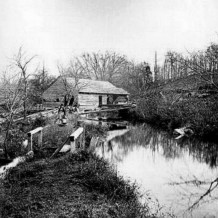
Our first clue of a mill having been in “Scroggie Valley,” now Glen Providence Park, was in local historian Dr. Anna Broomall’s 1700’s Newlywed Ghost Story – a bit of local folklore with details that launched much research about the valley’s early history, and yielded the discovery that the park had once been called Scroggie Valley! I gradually found more evidence of a mill in early newspapers, maps, and local history books. It turns out the 1800’s shingle mill was the site of some unfortunate events – and there is possibly even an 1864 photograph of the mill!
A millrace through Glen Providence Park?
The 1700’s Newlywed Ghost Story had this intriguing hint of a mill having been in the park: “The ghost of this unfortunate woman was for many years afterwards reported to walk up and down the valley to the west of Media along the old race bank which extended from Scroggie about as far up the valley as the present Broomall’s Lake. The remains of this race bank are still visible.” These sentences led to a determined search for any reference to a millrace (mill stream) or mill in Glen Providence Park, and the eventual compilation of several pieces of evidence that it existed!
A 1909 map shows the residence of the Little family, at the southwest end of Glen Providence Park in Upper Providence, named Scroggie. The 1948 obituary of Louis Little indicates that his family estate Scroggie “was named for an old shingle mill that was located in the valley where Glen Providence Park is now situated.” According to this, the Scroggie home and Scroggie Valley were named after the shingle mill!

1855 Close-up showing the Shingle Mill Stream that was diverted from Broomall’s Run within what is now the park – to power the shingle mill near Ridley Creek.
This seemed anectodal until discovering the shingle mill stream clearly marked on an 1855 map of Media, starting just below 3rd Street (the future location of Broomall’s Dam), and running along the western (Upper Providence) side of the valley, while the natural stream continued along the Media side of the valley. An 1860 map of Chester County marks the location of the shingle mill near Ridley Creek!
So what is a shingle mill, and when was it built?
A shingle mill is used to slice a section of log into tapered wedges to make wooden shingles. Before asphalt shingles, most roofs were covered in wooden shingles. You can see photos and videos of antique shingle mills in use on the Ontario Steam Heritage Museum website. Being water-powered, the Scroggie Shingle Mill used a millrace that diverted a portion of water from the natural stream. The millrace would be engineered to accelerate the water down a manmade channel through the valley, turning the water wheel that powered the sawblade at the mill.
According to Dr. Anna Broomall’s notes from 1909, in 1848 John Hill “built the mill for splitting shingles, but, owing to some deficit in the method, the work was soon abandoned… It is not known with whom the name “Scroggie” (pronounced Scrogie, long o and hard g) originated, it dates, at least, as far back as the Hill ownership.” It would seem the shingle mill caused Mr. Hill some headaches over the next decade…
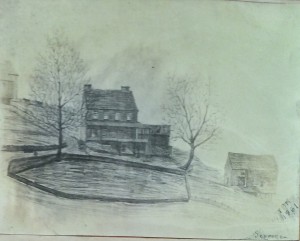
1861 drawing of the Scroggie house – from Anna Broomall’s collection at Delaware County Historical Society
Media’s first fire, and a lawsuit!
The shingle mill was the location of the first fire in Media on June 20, 1851, which, according to the 19th century historian Henry Ashmead, was “the first untoward event in the infant village” (Media was founded in 1850). He indicates “There was no similar disaster until after the lapse of eight years.” The newspaper reported, “The shingle factory of John Hill, at Media, together with a quantity of lumber was destroyed by fire on Friday last. We have heard no estimate of the loss.”
Mr. Hill apparently rebuilt the mill, only to be sued by his neighbor in 1857 over its operation. The outcome of John R. Lewis vs. John Hill is detailed in the local papers. Mr. Lewis alleged that he was entitled to ½ the water of Scroggie’s stream (according to an undocumented 999-year lease), but that the flow of water was frequently interrupted by the defendant placing gates in the run to power his shingle mill. The judge ruled that Mr. Lewis had the right to only about 1/6 of the stream’s water, for the purpose of watering his meadow, and for which he paid an ear of corn annually. The jury returned a verdict of $5 in damages for the plaintiff. It is unknown whether Mr. Lewis was satisfied with this outcome.
The shingle mill location… and an 1800’s photograph?
I have found no records of the Scroggie Shingle Mill in operation after 1861, but I did come across an intriguing photograph on Facebook of a “lumber mill on Ridley Creek in 1864.” The origin of the photo is unknown, but I decided to visit the likely site of the shingle mill within Glen Providence Park to compare the landscape to the 1864 photo. This is the location where the millrace that hugged the Upper Providence side of the valley would have been funneled by topography to join the natural stream, making it the logical location of the mill. The result is similar topography, as shown in these photographs!
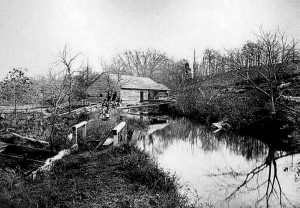
“Lumber Mill on Ridley Creek in 1864” posted by Harvey Martin on “I Grew Up In Media” Facebook page – origin of photo unknown.
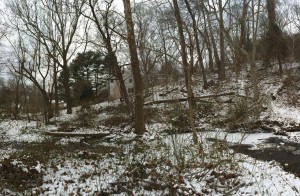
Probable Shingle Mill location in Glen Providence Park in January 2015 – the shingle mill would be just behind the large tree in the center of the photo
If this 1800’s photograph is of the Scroggie shingle mill, this would make the latest documentation of the mill in 1864, which, according to Anna Broomall, is the same year that Judge John M. Broomall purchased the Scroggie estate, then razed the original wooden house and built the current stone house in 1867. It is plausible that he would have razed the property’s shingle mill around the same time.
If anyone has more information on the source of the 1864 photograph, please contact us! Even if it were not an actual photo of the Scroggie Shingle Mill, it would be an example of a local mill during the same time period.
Observant hikers may find what seem to be signs of the old millrace along the western edge of the valley, bordering the wetlands. You can see the approximate location of the shingle mill marked on our 2011 Annotated Trail Map, which includes the “Shingle Mill Trail” nickname for the path leading to the mill site.
Click on the photos below for more evidence of the Scroggie shingle mill. Coincidentally, the Scroggie name seems to originate from the 1840’s, the same decade in which Charles Dickens was inspired by the gravestone of Ebeneezer Scroggie to write “A Christmas Carol.”
- Part of the 1855 Map of Media, showing Third Street before Broomall’s Dam was built in 1883
- 1855 Close-up showing the Shingle Mill Stream that was diverted from Broomall’s Run within what is now the park – to power the shingle mill near Ridley Creek.
- 1860 Map of Chester County – locating the shingle mill near Ridley Creek.
- 1861 drawing of the Scroggie house – from Anna Broomall’s collection at Delaware County Historical Society
- 1909 Map of Upper Providence Township – showing the “Scrogie” estate (usually spelled Scroggie) that shared a name with Scroggie Valley and the shingle mill.
- 2011 Annotated trail map of Glen Providence Park, showing the vicinity of the shingle mill
Sources:
- 1848 Map of Delaware County by Joshua W. Ash, M.D. from original surveys with the farm limits, courtesy of Delaware County Institute of Science, Media, PA
- 1855 Map of Media the Seat of Justice Delaware County, Pennsylvania by Thos. Hughes, C.E., courtesy of Media Historic Archives, Media, PA
- 1860 Map of Chester Co Pennsylvania by T.J. Kennedy, on display in the 2nd floor lobby of the Delaware County Courthouse, Media, PA
- 1909 Map from the “Property Atlas of Delaware County East of Ridley Creek,” courtesy of Media Historic Archives, Media, PA
- “Burned, ” Delaware County Republican, June 27, 1851
- “Error,” Delaware County American, June 17, 1857
- History of Delaware County, Pennsylvania, Henry Graham Ashmead, L.H. Everts & Co.,Philadelphia, 1884, p. 590
- “Lumber Mill on Ridley Creek in 1864,” I Grew Up In Media PA Facebook page, posted by Harvey Martin September 9, 2013, origin unknown.
- “John R. Lewis vs. John Hill,” Delaware County American, June 10, 1857
- “Local “Witches” of Long Ago Described by Dr. Broomall,” Chester Times, May 15, 1931
- “Louis Little, Rifle Expert, Broker, Is Dead,” Chester Times, November 13, 1948
- Ontario Steam Heritage Museum, http://woodgears.ca/steam_museum/shingle_mills.html
- Photograph album collection of Dr. Anna E. Broomall, Delaware County Historical Society, Chester, PA
- The Rose Tree Families, Jane Levis Carter, KNA Press, 1984




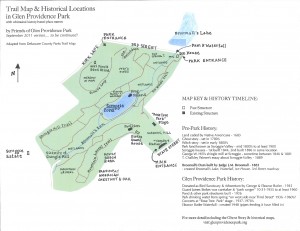








Recent Comments